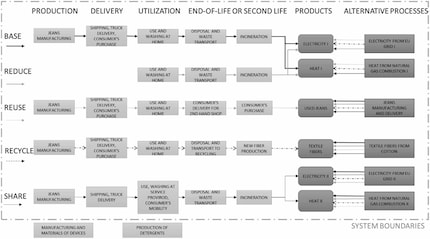
Background information
The man with 15,000 pairs of jeans: «I never wash my denim»
by Vanessa Kim

When you clean out your wardrobe, think about what to do with your old clothes. According to a study, in certain cases recycling and renting out a garment is worse for the environment than disposing of it.
Sustainability has long been fashionable in the industry. Every fashion company is going green and buzzwords such as «recycling» and «renting» are omnipresent. But how sustainable are these business models really? Researchers at the Finnish LUT University have investigated this question. For their study, published in the journal «Environmental Research Letters», they calculated the greenhouse gas emissions associated with different fashion consumption patterns. Jarkko Levänen and his team found that renting (and then recycling) clothes has the most negative climate impact.
Buy, wear, throw away – that’s how the linear fashion system works. The «Circular Economy» aims to break through this system in order to extend the life of clothing, avoid waste and reduce the consumption of raw materials. The aim is to wear clothes for as long as possible and then recycle them. By doing so, as many raw materials as possible go back into the production process and the usage of resources and raw materials is increased in the long term. So much for the theory. Here’s what it reality looks like: most fashion corporations adopt just one small aspect of this promising cycle to promote greenwashing. Recycling and the possibility of renting clothes instead of buying them are the most common promises. To prove their hypothesis, the scientists compared five different life cycles of a pair of jeans and calculated the climate footprint for each scenario.
In this study, the life cycle of a pair of jeans always starts the same: the pants are produced and shipped abroad. Once you buy them in the store or receive the parcel, things get interesting. Now it’s your turn, the life of the pants is in your hands. You can either wear them for a while before throwing them away, renting them out or recycling them, or you can wear them until they’re unwearable. The latter would be the ideal case.
Assuming you sell your pants to a thrift store after wearing them for a long time and then someone else wears them for a long time, the emissions are much lower than if the jeans are rented out to multiple people. This is because the constant transportation of the garment results in high CO₂ emissions. With a fictitious period of five years, this process takes place 50 times if the pants are rented out ten times per year. That’s a lot more than in the one-time case of the second-hand store. The estimated footprint stays the same during the hand-over process. With each additional rental, the overall footprint increases.
The same applies to remanufacturing. Just because garments can be recycled, it doesn’t grant a free pass or an excuse to dispose of them prematurely. On the contrary: according to the above-mentioned study, the industrial reprocessing causes high CO₂ emissions. That’s why it’s better to wear one pair of pants for a long time and throw them away than to buy five pairs of pants at the same time and have them recycled. In short: one life cycle with disposal is less environmentally damaging than five cycles with recycling. Recycling doesn’t abolish your consumer sins. However, a long life cycle with recycling is also better and more sensible than five short cycles with disposal.

With this study, the researchers don’t want to demonise recycling technologies in any way. However, they point out that there’s still a lot of tweaking to be done to get sustainability efforts moving in the right direction. The conclusion of the scientists: conscious consumer behaviour is the key to greater sustainability. But in the fast-paced fashion world where one trend follows the next, many aren’t (yet) ready for this sacrifice. And that’s the catch 22: the fashion industry will only become environmentally conscious if consumers consume thoughtfully and companies produce less.
When it comes to consumption, the key question is: who needs to change their behaviour to change the overall situation? The industry says: we only do what the customers want and they want new clothes all the time. Consumers say: manufacturers should stop producing such cheap goods, then we’ll automatically buy less. The problem is that as long as you can shift the responsibility onto the other person, you have an excuse not to change. Fact is: you can only directly influence your own behaviour. Thinking about consumption, not only in the case of clothing, is becoming increasingly popular. And concerning jeans, good quality denim pants will last almost forever. «The less you wash it, the better,» says jeans expert Ruedi Karrer. Find out why he would «never» wash a denim fabric here:
When I’m not exploring the depths of the sea as an open water diver, I enjoy plunging into the world of fashion. On the streets of Paris, Milan and New York is where I keep my eyes peeled for the latest trends. And I’ll show you how to take them from the catwalk to your everyday life.
From the latest iPhone to the return of 80s fashion. The editorial team will help you make sense of it all.
Show all